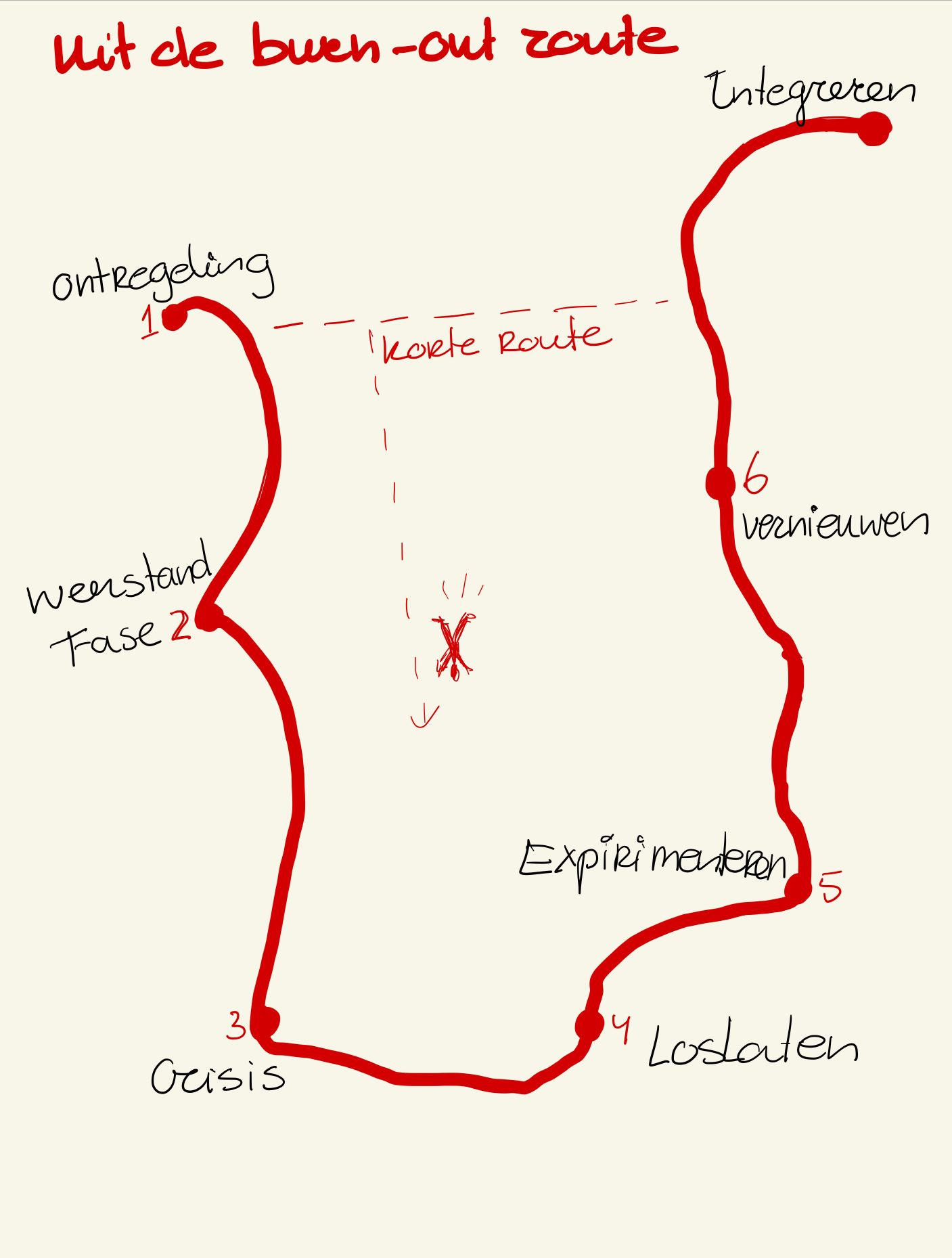Stress & Burn-out
What is stress?
Stress is the physical and mental response to events or situations that are experienced as threatening or challenging. It is a natural response that can help to cope with difficult situations, but long-term or chronic stress can be harmful to health. A period of extreme stress, without a recovery phase. And if the balance between load and capacity remains disturbed for a long time, all kinds of unpleasant symptoms and health problems occur and this can lead to chronic stress complaints, burnout complaints or even an adjustment disorder such as overstress or burnout.
What is a burnout?
A state of emotional, physical and mental exhaustion caused by prolonged and excessive stress. The superlative of chronic stress complaints. All signals that rest was needed have always been ignored. Common burnout symptoms are:
- physical complaints: headaches, stomach complaints, muscle pain and sleeping problems; emotional problems: feelings of anxiety, depression, irritation and crying fits; cognitive problems: difficulty concentrating, memory problems and indecisiveness; behavioral changes: withdrawal from social situations, absenteeism due to illness, different eating or sleeping habits.

Trauma in stress
A Few Facts About Trauma and Stress
- 70% of people experience some level of trauma at some point in their lives.
- Of those, 40% develop trauma symptoms or post-traumatic stress disorder (PTSD).
- With adequate support, help, and loving attention, trauma can resolve, leaving minimal lasting effects.
Three different types of trauma
There are three different types of trauma:
1. Single-Event Trauma:
This includes incidents such as accidents, natural disasters, war, robbery, rape, or surgery.
2. Developmental Trauma:
This refers to neglect, abuse, or sexual abuse experienced during childhood.
3. Generational Trauma:
This involves trauma symptoms being passed down from parents to children.
What is post traumatic stress disorder?
PTSD (Post-Traumatic Stress Disorder) is a psychological condition that can arise after experiencing or witnessing one or more traumatic events. It is a symptom of trauma.
Symptoms do not always appear immediately after the event; they can emerge months or even years later when triggered by a specific stimulus.
Some symptoms of PTSD include:
- Re-experiencing: Unwanted memories, nightmares, or flashbacks of the traumatic event, which can provoke intense emotions, sweating, trembling, or rapid breathing.
- Avoidance:Trying to block out parts of the memory, avoiding conversations, places, or people related to the trauma, and increasingly isolating oneself.
- Hyperarousal:Poor sleep, irritability, heightened alertness, feelings of depression and loneliness.
Not everyone with PTSD experiences nightmares, and symptoms can vary from person to person.
Can anyone get PTSD?
Anyone who has experienced a traumatic event as a victim or bystander can develop PTSD.
This includes not only war but also violent crimes, abuse, accidents, natural disasters, or serious illnesses.
While extremely severe and life-threatening situations increase the risk of PTSD, even "less severe" experiences can also lead to the development of PTSD.
To Paris at top speed
Fairly early in my career I bought a new Daihatsu Cuore, a bright red one. A spicy little car, which I was very proud of and had a lot of fun with.
So cool! A nice trip to Paris with friends, at 140 km/h, as fast as possible and therefore full throttle. Downhill she even reached 150.
Now you can describe my driving style (especially at that time) as spicy and I pull quite a bit through the gears (or I just shift up late, depending on how you look at it). Moreover, I liked to pace myself a bit and let's face it, 140 isn't even extremely fast. But with only 1000 cc of power it was hard work for the car.
Five years later, my beautiful bright red Cuore started having problems. She started leaking oil and showed all kinds of motor problems (all very technical, so I won't bore you with that). Continuously performing at top speed took its toll. My car was used up after 5 years. And of course I now have another car, with a heavier engine. I have also adjusted my driving style.
Stress works in principle the same and too much stress causes problems. The solutions are also similar. Either you increase your assets or you adjust your style. Or both.
How does a burnout occur?
Out of Balance
Problems arise when the burden becomes greater than the capacity to handle it. At this point, the demands placed on you, whether by others or yourself, exceed what you can manage. The balance between stressors—factors causing tension—and your ability to prevent or cope with stress tips unfavorably.
This imbalance can occur due to either an excessive burden or insufficient coping capacity. An excessive burden involves external demands and causes that are beyond your control. These stressful circumstances can vary widely, from everyday stressors to major life events.
Risk-increasing properties of burnout.
Sensitivity to Stress
People vary in their sensitivity to stress due to different personal characteristics and traits, resulting in varying levels of resilience. The following attributes can make a person more vulnerable to stress:
- Striving for perfection
- Traits like ambition, competitiveness, being task-oriented, feeling rushed, inability to relax, and multitasking
- Being demanding and setting high expectations for oneself (lots of rules and a strong sense of duty)
- High sense of responsibility
- Strong involvement in family or work
- External validation (sensitivity to others' approval)
- Difficulty saying "no" and setting boundaries
- Struggling to ask for help
- Difficulty expressing emotions
- Feeling a lack of control over one's life
In addition to personality and temperament, experiences and skills also play a significant role. Therefore, you can take steps to enhance your resilience. Through self-examination and self-reflection, you can better understand yourself, gain more self-awareness, and become conscious of self-imposed (and often unrealistic) rules and beliefs. This increased awareness provides more choices and allows you to set more realistic expectations for yourself and others.
Unhealthy lifestyle and work habits can also reduce resilience. Examples include poor eating habits, excessive coffee or alcohol consumption, lack of physical exercise, and insufficient sleep and relaxation.
Furthermore, poor work organization, excessive work, and inadequate breaks contribute to decreased resilience. This reduced resilience makes you more susceptible to the effects of stress.
Symptoms of burnout in women
Men and women show similar symptoms of burnout, but women are at greater risk. A burnout develops gradually, often after a long period of stress. Women are usually more sensitive to stress and are more likely to become tense.
How long does a burnout last?

Recovery from burnout can take some time, and predicting the exact duration is difficult.
Similar to the grieving process, several stages must be navigated. If one does not go through all the stages and opts for a quicker route, relapse is likely, which can prolong the recovery process even further.
Recovery also depends on various factors. Here are a few:
- The balance between resilience and burden
- The severity of the burnout symptoms
- The presence of risk-enhancing characteristics in the individual
- The level and quality of support and guidance
- The person's own rules and beliefs
- Physical condition
- And more
Consulting Google yields recovery periods ranging from three months to even two years, with some cases taking even longer.
What to do about a burnout?
It is difficult to find a solution with the same mindset with which you caused your problem. I recommend seeking professional guidance. Someone can give you specific feedback.
Getting Started on Your Own
- Be kind to yourself and listen to your body
- Ensure you get enough rest and physical recovery before engaging in activities.
- Establish a consistent daily routine; wake up on time and go to bed at a regular hour. Avoid sleeping during the day; instead, rest on the couch if needed.
- Eat healthy meals regularly.
- Alternate between rest and activity.
A professional guide can assist you in setting up a daily routine, help identify the root causes of your burnout, and support you in becoming aware of self-imposed (and often unrealistic) rules and beliefs. This process gives you more options for managing stress in the future.
What are serious burnout symptoms?
When burnout symptoms have been ignored for a long time, far-reaching physical and psychological problems can arise that affect behavior and even thoughts and thinking. We are then talking about very serious burnout symptoms.
Physical Symptoms
Stress can manifest physically with symptoms such as headaches, back pain, neck pain, heart palpitations, or digestive disorders. The immune system may also be compromised, making you more susceptible to colds and flu. Common issues include fatigue, restlessness, and sleep disturbances. In severe cases, muscle weakness and difficulty speaking can occur. Stress can even cause one limb to become temporarily paralyzed or numb, such as an arm or leg.
Psychological Symptoms
Stressed individuals often feel irritable or cynical. Stress can also lead to feelings of helplessness, unhappiness, or boredom. Unhealthy stress significantly impacts one's mood and emotional state, and people may feel isolated.
Behavioral Symptoms
Behavioral changes due to stress can include being bossy, snapping at others, or becoming overly critical. It may also result in increased use of alcohol, drugs, cigarettes, or overeating. These changes often stem from the physical and psychological symptoms of stress. Irritability can lead to conflicts, while lethargy or sadness can cause withdrawal from social interactions.
Cognitive Symptoms
Unhealthy stress can impair cognitive functions, leading to difficulty thinking clearly, a lack of creativity, memory issues, and concentration problems. It often fosters a negative thought pattern, and individuals may lose their sense of humor.
Help with stress & burnout
Most clients who come to my practice, with any request for help, long for peace, peace in their heads and peace in their bodies.
Tips for rest and relaxation
- Breathing exercises do box breathing to calm the mind and body: breathe in through your nose for 4 seconds, hold for 4 seconds and breathe out through your mouth for 4 seconds, wait and hold your breath out for 4 seconds (repeat 4-5 times until you have become calmer.
- Visualize: sit quietly, possibly close your eyes for a moment and imagine a peaceful and quiet place in your mind and stay there for a while.
- Go out into nature, reflect on what you see, smell, you hear, etc.
- Cuddling with your dog or cat, or just petting your pet is very soothing.
- Listen to music that relaxes you.
- Seek help! Do you even suspect burnout or do you have burnout complaints? Then seek help.










